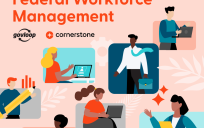This blog post is an excerpt from GovLoop’s recent guide “How to Effectively Communicate Government Workforce Reforms.” In it, we provide an overview of key workforce reforms happening at all levels of government. Download the full guide here.
To be clear, succession planning isn’t an HR issue; it’s a workforce issue for everyone, and it takes commitment, planning and thoughtful execution.
That’s why the Office of Personnel Management is using feedback from its 2017 Senior Executive Service (SES) Exit Report to improve government succession planning, as well as recruitment, engagement and retention. The survey found that formal succession planning is not the norm for senior-level positions. Sixty-one percent of senior executives leaving government said their agencies had no formal succession- planning efforts for executives, and more than half — 56 percent — said their agency made no efforts to involve them in preparing their successor. This isn’t just an SES problem but one that reaches across the workforce.
In Cary, North Carolina, Sean Stegall noticed there was a gap among his 1,200-employee workforce between those with vast amounts of knowledge and those without. That knowledge gap became more pronounced a few months after Stegall became Town Manager. At the time, three seasoned directors announced they were retiring. Their departures were disruptive because they left a deficit in expertise and know-how that mid-level managers were not equipped to fill.
“The department directors were very much relied upon to have it all and do it all,” Stegall said. That’s not a sustainable model.
Effective succession planning isn’t easy and takes time, but it’s worth the investment because it helps future-proof your organization for inevitable staff departures. Below we’ve outlined some practical ways that agencies can work with employees on effective succession planning.
1. Think outside the box. That may mean rethinking current and future job descriptions. Stegall said he recently hired two directors of special projects whose responsibilities are “other duties as assigned.” They are going to go where the need is, and in a couple of years they will know a little about a lot of things instead of focusing on a single department or project. Individuals in this type of role should find questions more comforting than answers, be humble and take satisfaction in the success of a team, have an appreciation for the unknown, and be resilient, Stegall said.
2. Start preparing readiness candidates. One way is by working with leaders to see who could potentially fill positions before they become vacant. What type of development are those candidates receiving, and have you spoken with them about their aspirations, skills and skills gaps that would preclude them from moving into certain roles? Create a competency-based learning and development model for individual contributors, supervisors and agency heads. The model should make clear what the competencies are for each role.
3. Identify your exposure in terms of potential skills gaps. What is the impact if key employees retire or resign? How would your agency respond to these events? What plans are in place? For example, does your agency anticipate that the workforce will grow? Will new skills be required?
4. Determine what development opportunities are in place for employees. If your organization conducts employee engagement surveys, use that data to gauge sentiments about career opportunities and the ability to be promoted. Use the data to drive actions and make improvements.
5. Review all of your data. The number of retirement-eligible employees isn’t the only data agencies must consider. Part of readiness planning is identifying how many people could leave and when that is most likely to happen. That’s where data analytics come in.





Leave a Reply
You must be logged in to post a comment.